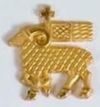History
The regiment has its origins in the unit Gotland National Conscription which was created in 1811. By a parliamentary decision in 1866 the Gotland National Conscription was transformed into an infantry regiment and an artillery corps (I 27 and A 4). A colonel was made regimental commander who also acted as the commander of Gotland's troops. The lieutenant colonel of the regiment came actually to serve as regimental commander until 1937. As of 1 January 1887 the regiment's name was Royal Gotland Infantry Regiment with the designation I 27. The regiment got a similar organization to other infantry regiments. The National Conscription's company area division remained until 1900 as the registration authority. [3]
In 1892, the agreement that Gotland's troops may not be called for military service outside the island was repealed. At the same time the name Gotland National Conscription was dropped. [3] In 1901, the army order on the mainland and Gotland became similar. This admitted, among other things, that conscripts from the mainland were transferred for training at I 27. There, at the same time, bicycle infantry training began. [4] In 1915, the regiment got Visborg Kungsladugård's land as training area and all the buildings as storehouses. [3] The bicycle infantry was developed during the World War I and the 1920s so far that I 18 (which the regiment was designated from 1928) circa 1930 became the Sweden's first bicycle regiment with motorized trains. [4]
The Defence Act of 1925 meant the end of the regiment. The regiment was downgraded to a corps which took over Västmanland Regiment designation I 18. The officers corps was reduced by 2/3. The mainland contingent of conscripts was also reduced substantially. [3] In 1936, the Royal Swedish Gotland Infantry Corps was upgraded to a regiment with the name Royal Gotland Infantry Regiment, I 18. [3] During World War II, armored units were added through the Göta Armoured Life Guards' Company in Gotland (P 1 G). Before the end of the war, this detachment was able to organize three companies (Stridsvagn m/42 and Stridsvagn m/37 and Pansarbil m/41). [4]
Through the 1949 war organization, I 18, supported by P 1 G, became responsible for an armored reinforced bicycle brigade of five battalions. The seven armored companies received via Stridsvagn m/41, Stridsvagn m/40, Infanterikanonvagn 102 finally Stridsvagn 74. [5] On 1 April 1963, the detachment was amalgamated with Gotland Infantry Regiment (I 18) and formed the Gotland Regiment (P 18) and was simultaneously transferred to the Swedish Armoured Troops. [6]
This page is based on this
Wikipedia article Text is available under the
CC BY-SA 4.0 license; additional terms may apply.
Images, videos and audio are available under their respective licenses.



